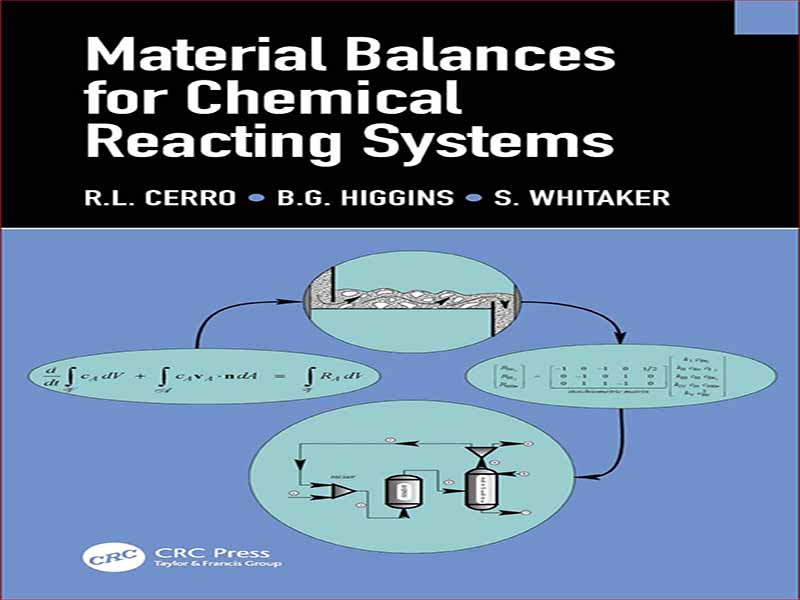- عنوان کتاب: Material-Balances-for-Chemical-Reacting-Systems
- نویسنده: R-L-Cerro,-B-G-Higgins,-S-Whitaker
- حوزه: واکنش شیمیایی
- سال انتشار: 2022
- تعداد صفحه: 328
- زبان اصلی: انگلیسی
- نوع فایل: pdf
- حجم فایل: 19.2 مگابایت
این متن برای استفاده در اولین دوره در یک برنامه مهندسی شیمی دقیق نوشته شده است. اولین دوره معمولاً پس از تکمیل مطالعات محاسبات و تحلیل برداری توسط دانش آموزان گرفته می شود و این موضوعات در سراسر این متن به کار گرفته می شوند. از آنجایی که دروس معادلات دیفرانسیل معمولی و جبر خطی اغلب همزمان با اولین دوره مهندسی شیمی گذرانده می شود، این موضوعات در صورت نیاز معرفی می شوند.
فصل 1 دانش آموزان را با انواع مشکلات تعادل ماکروسکوپی که آنها به عنوان مهندسان شیمی با آن مواجه خواهند شد آشنا می کند و فصل 2 مروری بر انواع واحدها (ابعاد) ارائه می دهد که باید به آنها تسلط پیدا کنند. در حالی که مفاهیم اساسی مرتبط با واحدها ذاتاً ساده هستند، کاربردهای عملی آن می تواند پیچیده باشد و دانشجویان مهندسی شیمی باید در این زمینه متخصص باشند. فصل 3 به تجزیه و تحلیل تعادل ماکروسکوپی برای سیستمهای تک جزیی میپردازد و این زمینه را برای فصل 4 فراهم میکند که به تجزیه و تحلیل سیستمهای چند جزئی در غیاب واکنشهای شیمیایی میپردازد. فصل 5 تجزیه و تحلیل سیستم های دو فازی و مراحل تعادل را ارائه می دهد. این نیاز به مقدمه ای کوتاه بر مفاهیم مرتبط با تعادل فاز دارد. فصل 6 به استوکیومتری می پردازد و چارچوبی را برای مطالعه سیستم های دارای واکنش و جداسازی ارائه شده در فصل 7 ارائه می دهد. فصل 8 به سیستم های دسته ای ثابت و گذرا با و بدون واکنش های شیمیایی می پردازد. فصل 9 ارتباط بین استوکیومتری همانطور که در فصل 6 ارائه شد و طراحی راکتور همانطور که در دوره های بعدی ارائه شد را فراهم می کند.
در سرتاسر متن، میتوان مشکلات مختلفی را پیدا کرد که از آنهایی که با دست قابل حل هستند و با مشکلاتی که از استفاده از نرمافزار رایانهای سود میبرند، خاتمه مییابند. مسائل برای نشان دادن مفاهیم و کمک به توسعه مهارتها انتخاب شدهاند و راهحلهای زیادی به عنوان کمکی برای مربیان آماده شدهاند. دانشآموزان تشویق میشوند از مسائل برای آموزش مفاهیم اساسی مرتبط با تجزیه و تحلیل تعادل ماکروسکوپی چند جزئی استفاده کنند، سیستمهای واکنشدهنده برای این نوع تجزیه و تحلیل موضوعی تکرارشونده در طول زندگی حرفهای آنها خواهد بود.
بسیاری از دانشجویان و اساتید در تکمیل این متن مشارکت داشتهاند و تعداد زیادی وجود دارد که نمیتوانیم آن را به صورت جداگانه شناسایی کنیم. با این حال، اگر به این نکته اشاره نکنیم که پروفسور روبن کاربونل برای اولین بار این رویکرد را برای تعادل مواد آموزشی در دانشگاه کالیفرنیا دیویس در اواخر دهه 1970 معرفی کرد، ناامید خواهیم بود.
This text has been written for use in a first course in a rigorous chemical engineering program. That first course is generally taken after students have completed their studies of calculus and vector analysis, and these subjects are employed throughout this text. Since courses on ordinary differential equations and linear algebra are often taken simultaneously with the first chemical engineering course, these subjects are introduced as needed.
Chapter 1 introduces students to the types of macroscopic balance problems they will encounter as chemical engineers, and Chapter 2 presents a review of the types of units (dimensions) they will need to master. While the fundamental concepts associated with units are inherently simple, the practical applications can be complex and chemical engineering students must be experts in this area. Chapter 3 treats macroscopic balance analysis for single component systems and this provides the obvious background for Chapter 4 that deals with the analysis of multicomponent systems in the absence of chemical reactions. Chapter 5 presents the analysis of two-phase systems and equilibrium stages. This requires a brief introduction to concepts associated with phase equilibrium. Chapter 6 deals with stoichiometry and provides the framework for the study of systems with reaction and separation presented in Chapter 7. Chapter 8 treats steady and transient batch systems with and without chemical reactions. Chapter 9 provides a connection between stoichiometry as presented in Chapter 6 and reactor design as presented in subsequent courses.
Throughout the text, one will find a variety of problems beginning with those that can be solved by hand and ending with those that benefit from the use of computer software. The problems have been chosen to illustrate concepts and to help develop skills, and many solutions have been prepared as an aid to instructors. Students are encouraged to use the problems to teach themselves the fundamental concepts associated with macroscopic balance analysis of multicomponent, reacting systems for this type of analysis will be a recurring theme throughout their professional lives.
Many students and faculty have contributed to the completion of this text, and there are too many for us to identify individually. However, we would be remise if we did not point out that Professor Ruben Carbonell first introduced this approach to teaching material balances at UC Davis in the late 1970s.
این کتاب را میتوانید از لینک زیر بصورت رایگان دانلود کنید:




































نظرات کاربران